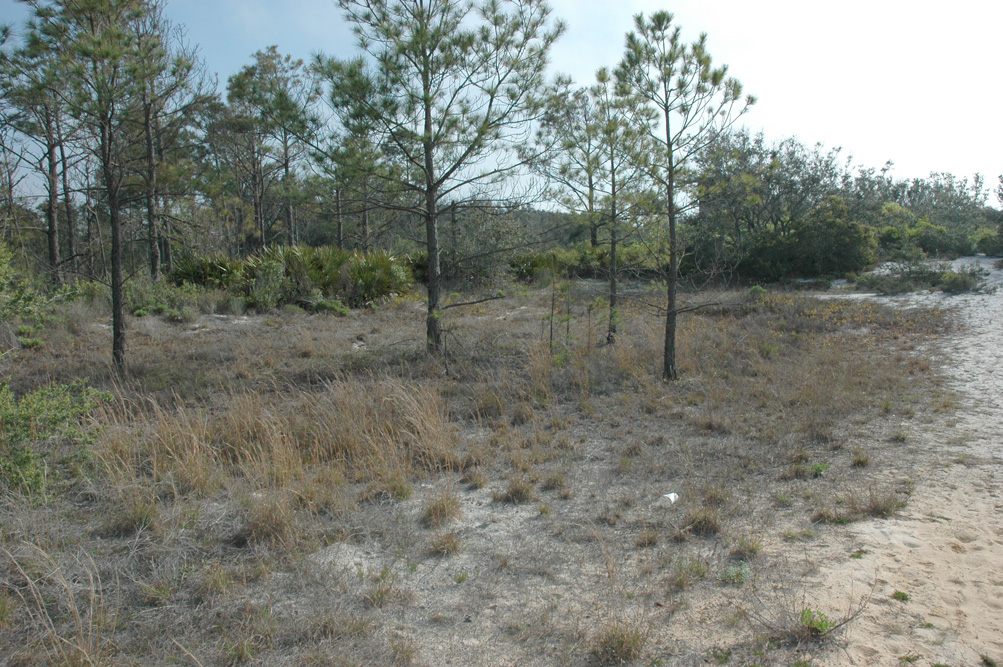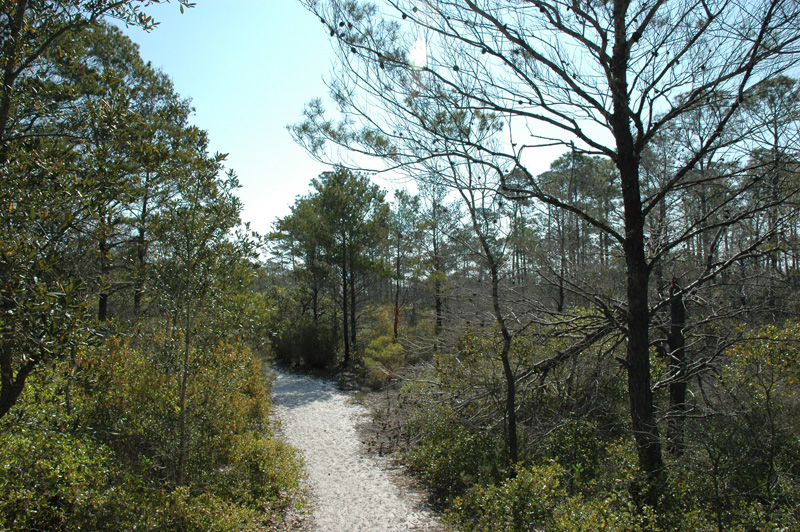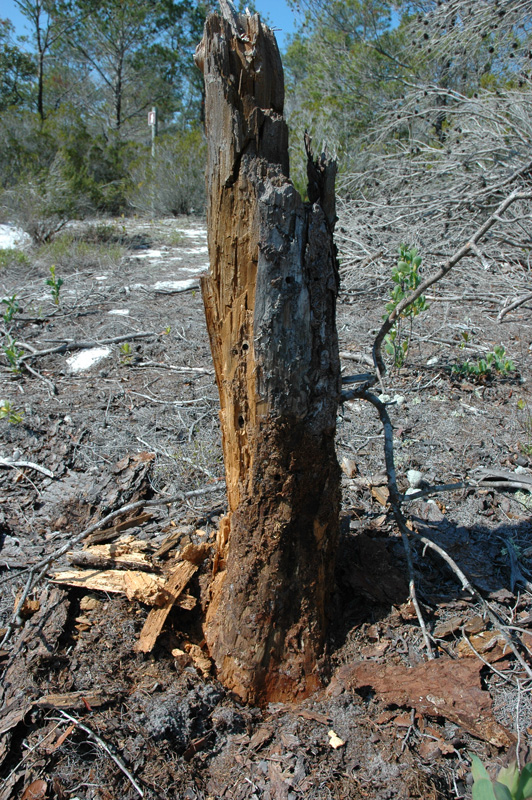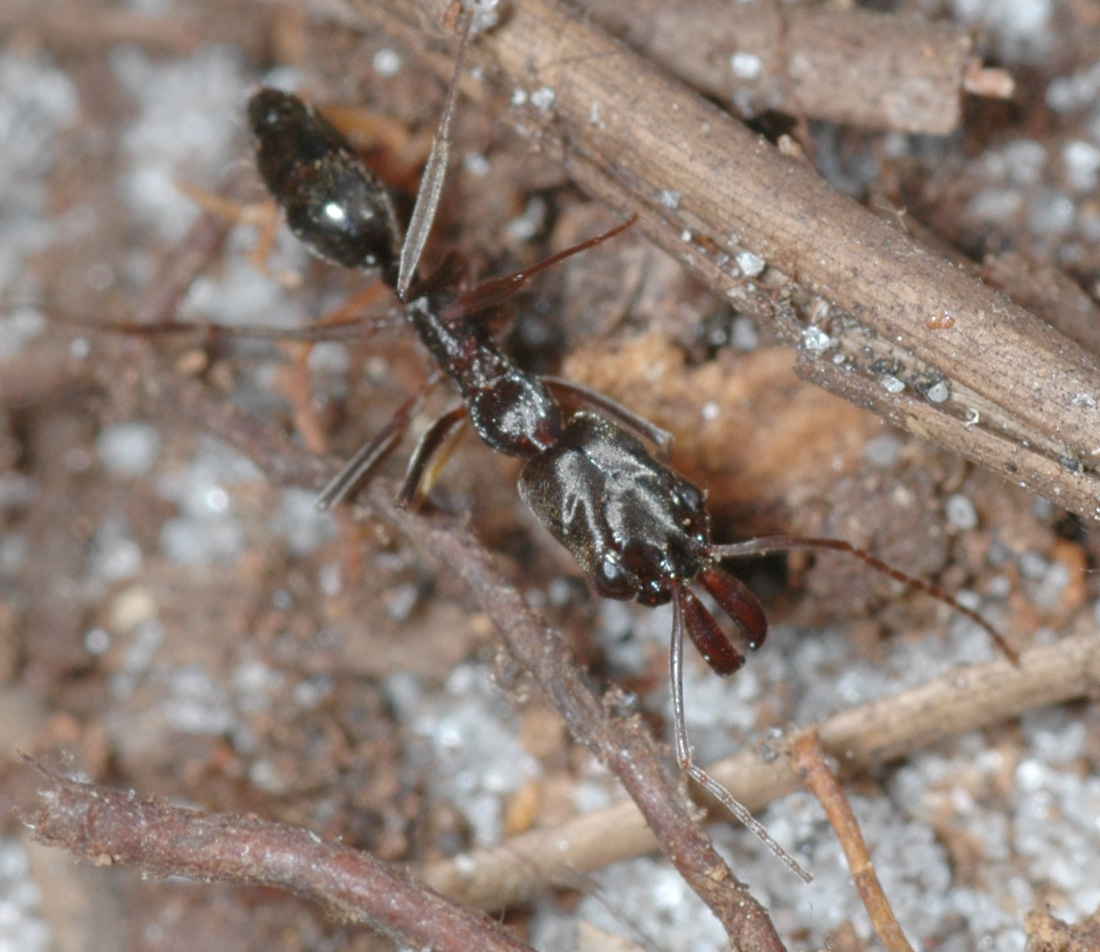Ants of Bon Secour National Wildlife Refuge, Baldwin County, Alabama
Joe A. MacGown and JoVonn G. Hill
March 2007

A view of the beach at Bon Secour NWR near dusk
The Bon Secour National Wildlife Refuge consists of approximately 7000 acres and is located directly west of Gulf Shores, Alabama on the Fort Morgan peninsula in southwest Alabama. Although small compared to many national refuges, Bon Secour NWR is of great importance providing wildlife habitat for migratory birds, nesting sea turtles, and many other animals. Primary concerns of the refuge are the preservation of the coastal dunes ecosystem, protection of threatened and endangered plant and animal species, and providing recreational opportunities for visitors. A variety of habitats can be found on the refuge including beaches, sand dunes, scrub forest, fresh and saltwater marshes, fresh water swamps, and upland areas.
Although much of the flora and fauna has been studied at Bon Secour NWR, little work has been done on the insects of the area. Much of the research that has been done on insects has been in the form of general collections by the Mississippi Entomological Museum (MEM). These preliminary studies have resulted in the collection of some interesting species, including some that were new to science, and others that were relegated to living in the specialized coastal dune ecosytem. During the course of these collections various species of ants were also collected. At the time, some of the ant species were new state records for Alabama and represented species previously only thought to have occurred in Florida. A comparison of species found at Bon Secour with species from Horn Island, off the coast of Jackson County, Mississippi, shows that the species composition is similar (Horn Island ants). This is not surprising given that Horn Island was at one time connected with the coastline of Alabama and Mississippi. To better document the ants of Bon Secour, a collecting trip was made to the area on 28 and 29 March 2007. Because this trip was made in conjunction with our monitoring prickly pear cactus (Opuntia spp.) in the area for invasive cactus moths, we had limited time to collect. Future trips at different times of the year and in all habitats at the refuge would be beneficial and help us to more fully understand the ant fauna of the area.

The fore dunes, just beyond the beach area
We arrived at the refuge late in the day after 6:00 PM with temperatures in the mid 70's (F). We concentrated our efforts on the fore dune area (30°13'43"N87°49'51"W) because of the unique nature of the habitat. As we started walking west from the parking area between the large dune formations and a low area with numerous palmettos and scraggly pines, we immediately noted the presence of many ant colonies in the sand. A variety of species were seen in this area. Dolichoderine ants were especially dominant and we observed and collected dark brownish colored Dorymyrmex grandulus (Forel) and Forelius pruinosus (Roger). We noticed the workers of Forelius in one colony appeared to have larger individuals than the other colonies we observed. Of course, colonies of the ever present exotic red imported fire ant, Solenopsis invicta Buren, were abundant in the area. Numerous colonies of the fungus growing Trachymyrmex septentrionalis (McCook) with their large, assymetrical, crescentic mounds were found in the sand as well.
As we walked along the trail and up onto some of the dunes, we observed the bicolored red and black Carpenter ant, Camponotus floridanus (Buckley), moving rapidly across the sand. They appeared to be more abundant as the temperature cooled and darkness approached. We attempted to find colonies of this species by searching in rotting wood, which is their preferred nesting habitat, but had no success. As darkness was nearing, we observed workers of Nylanderia phantasma (Trager), a small, pale yellow species known to inhabit sand dunes, crawling on the sand. This somewhat rare species was only first reported from Alabama in 2005 (MacGown and Forster, 2005). This species was also collected in recent years on Horn Island, Jackson County, MS. Because it was getting too dark to collect further, we departed the refuge in search of food.

The area just north of the fore dunes
The next morning we arrived at the refuge near 9:00 AM. where we planned on collecting in the same area as we had the previous evening. The sun was beginning to shine through, and the early morning fog had mostly dissapated. We took the opportunity to collect some more Dorymyrmex and Forelius species that were nesting in the area. There appeared to be some variation in the size and color of the Dorymyrmex and we were curious if there were more than one dark colored species in the area. Colonies with smaller workers tended to have darker individuals, whereas in colonies with larger workers the individuals were somewhat bicolored with the head and gaster dark brownish-black and the mesosoma reddish. We later decided that the colonies with larger workers were just dark variants of D. bureni (Trager) and the smaller, darker one were D. grandulus.

A crater above a colony of Dorymyrmex
We screened lots of litter beneath the stunted oaks and pines in the dunes area, but found little diversity. Species collected in the litter included Brachymyrmex depilis Emery, B. patagonicus Mayr, Hypoponera opacior (Forel), Solenopsis carolinensis Forel (molesta group), P. dentata Mayr, Pheidole moerens Wheeler, and P. obscurithorax Naves. Brachymyrmex depilis is a pale yellow, native specie that nests in soil. Workers and queens in this genus can be recognized by their minute size and nine segmented antenna. Brachymyrmex patagonicus is a minute brownish-black exotic species that is rapidly increasing its distributional range across the southeastern United States. Colonies of Brachymyrmex also were found at bases of plants, under bark of pines, and in rotting wood. They were seen in great abundance throughout the area as workers foraged on the ground and on vegetation. The brown colored Hypoponera opacior is a common litter and soil inhabiting species and we were not surprised to find it. The minute yellow workers of the S. molesta species group are also commonly found in litter and soil, but unfortunately are very difficult to identify without queens, which were not found. However, the workers appeared to be S. carolinensis, a common species in sandy soils in the region. Two of the Pheidole species, P. moerens and P. obscurithorax, that were collected in the litter are also introduced and increasing their range. The two species are easily differentiated from one another as P. moerens is a small reddish-brown species, whereas P. obscurithorax is dark brown and much larger in size. Pheidole dentata is a ubiquitous species that nests in soil or in rotting wood and colonies are typically large. Workers are bigger than those of P. moerens, but much smaller than P. obscurithorax. This species is somewhat elongate, with a smooth and shiny head, is very pilose, and is variable in color, ranging from reddish brown to brownish black.
Colonies of another exotic species, Odontomachus haematodus Smith, were found in rotting wood and at the base of a pine tree. This large species is quite distinctive with its elongate snapping jaws and is aptly named the "snapping ant". This species can sting, therefore care must be taken when collecting it. The colony that was found beneath the pine was large, and hundreds of workers were observed exiting the colony when it was disturbed. However, the full size of the colony was not determined because we did not want to adversely affect the health of the tree by cutting into it. This species is another that was only recently reported from Alabama (MacGown and Forster, 2005).
A worker of Odontomachus haematodus
After approximately 1.5 hours, we headed north to Gator Lake trail where we collected in the "hind dunes" area (30°14'10"N87°49'49"W). We collected in this area for a couple of hours, and found the same array of species that we found in the fore dunes. The sand was littered with Dorymyrmex and Forelius colonies. We also found nests of B. patagonicus, T. septentrionalis, S. invicta, and P. moerens throughout the area. The colonies of P. moerens were found in rotting wood and scattered along the edges of open areas. One other native Pheidole, P. floridana Emery, was found nesting in the soil along the edge of the trail. This species is similar in size and appearance to P. moerens, but it bright yellow and has other subtle differences in sculpture.

Gator Lake Trail, in the hind dunes area
Many small craters approximately 5 to 6 cm in diameter were observed in open sandy areas. Excavating the nests resulted in the finding of Nylanderia phantasma. However, we were never able to find many workers in the nests and we thought that perhaps the nests were quite deep. Workers of this species are much easier to collect at night when they are active.
We found a large colony of C. floridanus in a rotting pine stump. The colony was revealed when bark was pulled away from the stump and hundreds of workers came streaming out. Many workers were observed carrying brood, which they were reluctant to drop even when disturbed. A single dealate queen was observed, but not collected. The workers of this species were very aggressive and showed no compunction about biting humans!

Pine stump in which Camponotus floridanus colony was found
Overall, the diversity of ants that we collected in the dunes was low, and we only collected 17 species of ants. However, this was not surprising for such a harsh environment that its periodically inundated with salt water. Five of the species that we collected are considered to be introduced (from South America). This high proportion of exotic species to native species appears to be typical across the coast of both Alabama and Mississippi. We had hoped to find colonies of the Florida harvester ant, Pogonomyrmex badius (Latreille), which we had collected on previous trips, but did not find any on this particular outing. The ant fauna in the sand dunes here appears to be quite similar to that of Horn Island, which is located just off the coast of Jackson County, Mississippi (Horn Island Ants). Bon Secour has have the following species in common with Horn Island: D. bureni, D. grandulus, F. pruinosus, B. depilis, B. patagonicus, N. phantasma, C. floridanus, H. opacior, T. septentrionalis, S. carolinensis, S. invicta, P. badius, and P. moerens. To compare the species of ants from Bon Secour to other localities with similar habitats, click on the links below under the heading "links to ants of other sandhill or sand dune habitats".
Ants from Bon Secour National Wildlife Refuge (including species collected on past trips)
Species are arranged alphabetically by genus.
Brachymyrmex depilis Emery
Brachymyrmex patagonicus Mayr Exotic
Camponotus floridanus (Buckley)
Dorymyrmex bureni (Trager)
Dorymyrmex grandulus (Forel)
Forelius pruinosus Roger
Hypoponera opacior (Forel)
Nylanderia phantasma (Trager)
Odontomachus haematodus (Linnaeus) Exotic
Pheidole bilimeki Mayr
Pheidole dentata Mayr
Pheidole navigans Forel Exotic
Pheidole obscurithorax Naves Exotic
Pogonomyrmex badius (Latreille)(collected on a previous trip)
Solenopsis cf. carolinensis Forel
Solenopsis invicta Buren Exotic
Trachymyrmex septentrionalis (McCook)
Literature Cited
MacGown, J. A. and J. A. Forster. 2005. A preliminary list of the ants (Hymenoptera: Formicidae) of Alabama. Entomological News 116: 61-74.
Links to ants of other sandhill or sand dune habitats
Ants of Deaton Preserve, Greene County, Mississippi
Ants of Horn Island, Jackson County, Mississippi
Ants of Palestinean Gardens, George County, Mississippi
Ants of Fall Line Sandhills Natural Area, Taylor County, Georgia
Ants of Ohoopee Dunes Natural Area, Emanuel County, Georgia
Ants of Big Hammock Natural Area, Tattnall County, Georgia



